DIY Homemade Yogurt
Have you ever tried making your own homemade yogurt? This detailed post will give you all of the tools you need to make it yourself at home!
I have to tell you that since moving to our tiny little town stuck in the Northern reaches of Minnesota, I’ve realized that if I don’t start getting in touch with the inner reaches of my resourceful soul (I swear, it’s in here somewhere), I’m going to be in big trouble.
Mainly because I don’t have the same access to groceries and “things” that I used to have. Let’s face it – I was spoiled. Big time.

And now my family is learning the true meaning behind the phrase “make it do or do without” or rather “make it ourselves or do without” in our food-loving case.
I’m not saying we can’t buy stuff; we can. But I don’t have the luxury of seventeen flavors of organic, Greek yogurt staring me in the face at the store. Which brings me to this post. In fact, I’m so excited to share it with you that my fingers may or may not be shlowken…I mean, shaking.
In the last three months, I’ve made this DIY yogurt nearly weekly.
I wanted to really have the method perfected before sharing it with you, and I can honestly say I am as sold on making this yogurt as a regular part of our lifestyle as I am making all of our bread, which was a huge leap for me when I first started over three years ago but now seems like second nature.
Once you get the hang of it, this yogurt is practically mindless. I have it down to a science.
I know that by starting it by 3:00 or 4:00 in the afternoon, I’ll be ready to pop it in the oven for an overnight rest by 10:00 or 11:00 and it will be strained and devour-able by 2:00 the next afternoon.
Besides taking the yogurt’s temperature (think of it as a beloved child you are nurturing) and moving it from point A to point B, this couldn’t be simpler.
When I initially tried it, I figured it would be kind of neat-o and novel to make my own yogurt. But I didn’t count on the absolute delicious, creaminess of this yogurt. In my opinion, it beats out any storebought yogurt I’ve ever had – Greek or regular. And if you live in the boonies like I do where grocery prices are a little bit inflated, it’s very cost efficient to make it yourself.
I’ve included a step-by-step tutorial along with the recipe. And I’ve added lots and lots of notes to the recipe in order to help you along (basically my finds after dozens of times making this) so please settle in and read through it all.
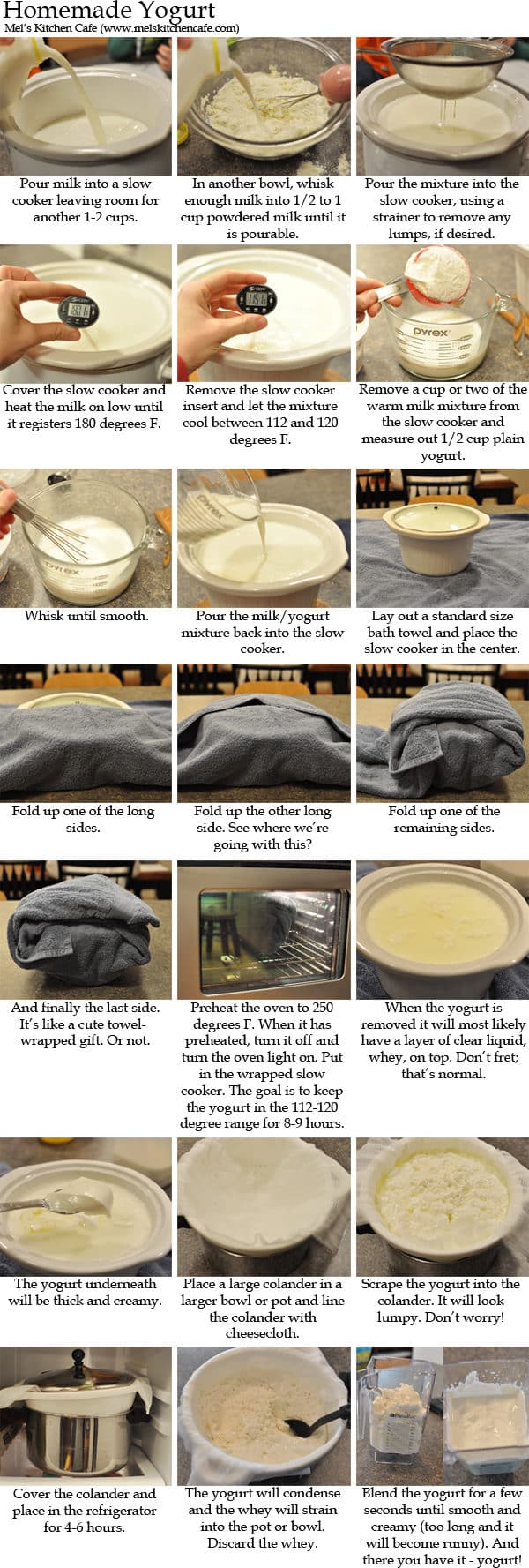
It’s riveting and educational and it will make you smarter while changing your life.
Ok, not really to any of those things, but seriously…get on the yogurt making bandwagon! You’ll definitely be the cool kid in town, no doubt about it, and I’ll be here to hold your hand through the journey. Promise.
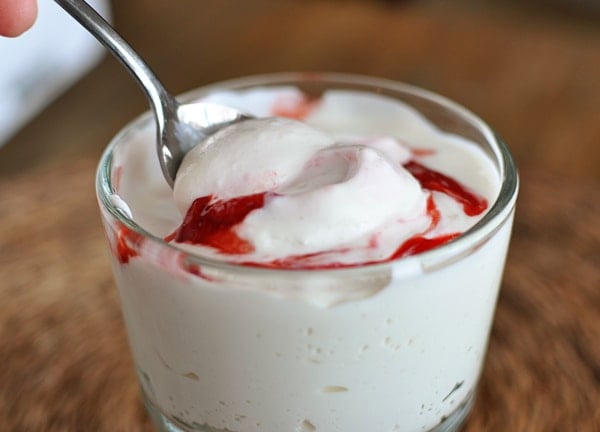

DIY Homemade Yogurt
Ingredients
- 1 gallon milk
- ½ to 1 cup nonfat dry milk powder, optional
- ½ cup plain yogurt with live and active cultures, look at the ingredient list to make sure it includes Lactobacillus bulgaricus and Streptococcus thermophilus
- Fruit syrup, if desired (recipe below)
Instructions
- Pour one gallon of milk into a 5-quart slow cooker, leaving enough room for 1-2 cups more liquid. See the note above for adjustments if you are working with a larger or smaller slow cooker or pan. Whisk a cup or so of milk into 1/2 to 1 cup powdered milk until the mixture is smooth. The powdered milk is optional but adds protein and creaminess. Pour or strain the powdered milk mixture into the slow cooker. Cover the slow cooker and heat on low until the mixture reaches 180 degrees F (in my slow cooker, this takes about 2-3 hours, although each slow cooker will heat a bit differently). Remove the slow cooker insert and let the milk cool to between 112 and 120 degrees F. Too warm or too cool and the milk won’t culture into yogurt. Without any stirring to help cool, it takes 1-2 hours for the milk to cool. Stirring will help the milk cool more quickly.
- Once the milk has cooled to that temperature range, measure out 1/2 cup plain yogurt (Greek or regular) in a small bowl and whisk in 1 or so cups of the warm milk into the yogurt. Whisk the yogurt/milk mixture into the warm milk. Now lay out a standard size bath towel and place the covered slow cooker in the center. Fold up each side until it makes a neat little towel wrapped package and the slow cooker is completely insulated. Preheat the oven to 250 degrees F. Once the oven is fully preheated, turn it off. Turn the oven light on. This will help maintain the warmth of the oven while the yogurt cultures. Place the towel-wrapped slow cooker into the warm oven. Let the wrapped pot sit in the warm oven for 8-12 hours. The idea is to keep the milk/yogurt mixture in the 112-118 degree range for that period of time. It is what cultures the milk and turns it into yogurt.
- After 8 or so hours, remove the pot, take off the bath towel and take off the lid. The mixture should be very thick and set and it may have a layer of clear liquid on the top (whey). If it is still too liquidy, return it to the warm oven for a longer period of time. If you think your oven may not be holding warmth, you may need to preheat it to 250 degrees and then turn it off every couple of hours but usually just keeping the oven light on after preheating it once should do the trick.
- Once the milk has successfully cultured and turned to yogurt, line a colander or strainer with cheesecloth and set it over a large pot or bowl. Pour the yogurt into the strainer. It may be lumpy but as long as it’s thick, it will strain just fine. Using lowfat milk will produce more whey and the yogurt will need more straining time; using whole milk will produce less whey and you may not even need to strain it at all. Place it in the refrigerator and let it drain for 4-6 hours. There will be quite a bit of whey in the pot or bowl. Discard this liquid. Scrape the yogurt off the cheesecloth into a bowl or other container. Whisk to recombine the yogurt. My yogurt, at this point, looks almost like cottage cheese and has little lumps no matter how much I whisk it, so I pour it into my blender and blend it for a few seconds (too long and it will become runny). The yogurt can be stored in the refrigerator for 1-2 weeks. If you want to continue making yogurt like this, reserve 1/2 cup of the yogurt to use as a starter in your next batch.
Notes
Recommended Products
Yogurt Inspiration: Taken from Annie’s Eats and Jillee, among many other sources and sites around the internet

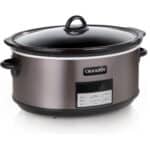
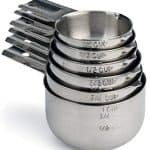
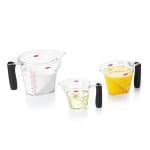




Hello from Texas! I found your blog while searching for how to flavor up my first time ever batch of homemade yogurt. I’m bookmarking this page for next time. I would’ve never thought of the oven for a warm place to ferment! Duh! LOL. In reading through the comments, I noticed that you mention adding sweeteners and flavors to your yogurt before the fermenting process. I’m wondering if that makes your yogurt unusable as a starter culture for the next batch? If so, how do you pull enough out before flavoring for a starter culture? I know this is an old post, but I really hope you see this and have some advice for me. Thank you!
You can still use the sweetened yogurt for a starter as long as you are making the next batch sweet, as well. Otherwise, it’s best to add sweeteners at the end after it has cultured so you can have a plain starter. Hope that helps!
I clicked on the link to print the pdf version of the step-by-step instructions but I get an error message stating that the page doesn’t exist. Is it still possible to get the pdf?
Thank you!
Let me try to find that file and reupload it, Mary!
A few days ago I stumbled across the fruit syrup recipe that was included in this DIY yogurt recipe, but today when I wanted to write down the recipe, I can’t find it. Am I losing my mind or did the simple recipe for the fruit syrup get moved? Thanks
It’s at the very bottom of the recipe in the notes section.
Thanks – I found it! I knew I was losing my mind last night 🙂
sorry I forgot. I heat milk in my microwave 14 minutes. let it cool to 108 temperature, then add just 2 tbsp plain yogurt. all the rest is the same as on the site I posted. all the rest is the same,
Mel this is the way I make my yogurt , an it is wonderful and thick after I strain it. Here is the website I got my method from.
http://www.keeperofthehome.org/making-homemade-yogurt-2. I add sweetner( have diebetis) fruit, jam, after it is all done. So good
I have a new ‘Instant Pot’ pressure cooker and it has a yogurt setting. Have you tried making yogurt in the pressure cooker? How long would I leave it to ‘cook’ in the second series of the instructions? The standard 8 hours still?
Hi Laurie – I’ve only made it in the Instant Pot once and it’s been a while…I still stick to my original method. You might try googling for more help or here’s a how-to from a fellow blogger: http://www.tidbits-cami.com/2015/09/homemade-yogurt.html
I just finished my first ever batch of yogurt, and I don’t know if it was a complete failure or not! I have been studying this recipe and your updated one for weeks, and spent a few days testing various methods of incubation with water, before finally venturing into actually using milk. Unfortunately, I could never get anything to hold a consistent temperature for longer than a couple of hours in my testing, but I decided to be brave and go for it anyway. I kind-of did a combination of this method and your new one, and I heated the milk on the stove to 180, added my sweeteners, then cooled it to 119, added the starter, and left it in my pot and stuck it in the oven. I used a thermometer with a wire attached to it so I could constantly check the temperature. The problem is, the temperature would get too low, and as I tried to adjust it by turning the oven on warm for a few minutes, it would then get way too hot. And since I couldn’t sit and babysit it ALL day long, I had variances of 90-130 degrees when I checked the thermometer! I finally pulled it out after 12 hours, and I don’t know what to do with it. It doesn’t smell bad, in fact, it smells quite sweet. The texture reminded me of flan or creme brûlée or something when I scooped it out to strain it, and the whey is quite yellowish… it looks a lot like lemonade. But my question is, is it ruined?? I don’t know if I dare eat it! My fear is that I killed the live cultures when the temperature went up, so when the temperature went down there was nothing to keep the bacteria at bay. Anyway, I’m going to stick everything in my fridge tonight and do some more research in the morning, but if you have any advice to offer me, I would greatly appreciate it!
Hi Suzanne – from the way you describe the finished yogurt, it seems exactly the result I get when I make homemade yogurt. So in that sense, I think it worked just fine! As for the bacteria issue, you might do some looking online to see. My gut feeling is that the yogurt is just fine!
Well, my family consumed all the yogurt, and no one ever got sick! So, I guess that means it was okay! It was so delicious… I think next time I will just stay away from the thermometers and let it do its thing. Thanks for the encouragement, and for the tasty recipe! I’m excited to try it again!
Hey! I absolutely loved your post on homemade yogurt. I have been making my own for a while now and love it. Just a little idea. Instead of discarding the whey, which is sooooo rich in protein and other nutrients, you can mix it into shakes and smoothies, use it as a water or milk replacement for bread ( OMG so freaking yummy!!) or pancakes and muffins etc….
I’d love love love it if you would an updated version of this using the Instant Pot to what I assume is a very long to do list. If you could include all your various types (vanilla, coconut, sweetened or unsweetened, etc), I would be eternally grateful! I can guess as to how you would adapt it, but I’d most likely get it wrong as I’ve never made it before.
Thanks Mel!!
I have been making yogurt for several months now with great success. I do not heat the milk on the stove because I am afraid of scorching it (I have a tendency to burn things no matter how attentive I try to be). I read several articles on using the microwave to heat the milk and decided to use that method. I heat it on high temp and in my microwave that takes about 16 minutes. – works great – I’ve never had a failure. I’m anxious to try your suggestions on adding flavor. Thanks for your helpful suggestions.
I made yogurt for the first time ever last night/today, and it turned out great! I heated it on the stove and then wrapped my pot in a towel and put it into the lighted oven overnight. I did manage to start my towel on fire when it brushed against the hot coils that had just preheated…no worries, I didn’t even need the fire extinguisher. However, I have a few questions. First of all, I see others commenting that they put their yogurt into 7-9 jars. Hmmmm…I made 1 gallon of 2% milk, and after straining, I only got 2 full quart jars. How are others getting so much from this recipe?! Second, the yogurt itself is quite tart plain. I am making yogurt parfaits for MOPS this week, so how would you suggest that I do that? Should I sweeten the yogurt with something first? Or will the honey in the granola and the chunks of fruit be sweet enough? If I add sugar, would it even dissolve? Thanks Mel–I am so excited about my new yogurt-making skills!
Hi Melanie – I usually yield about 2-3 quarts for every gallon of milk I make. Interestingly, it depends on brand. Some brands of milk yield less and give off more whey during straining. And of course it also depends on how long you let the yogurt strain, too. I like to add sweetener during the cooking/cooling process (I usually use agave nectar) but I think you could definitely sweeten it lightly now, too. I’d try to use a liquid sweetener (honey or agave nectar or something like that), otherwise, I think it might taste a little granular from the sugar.
Just wanted to say ‘thumbs up’ to Judy J – it is came out so thick and creamy-very,very happy with it-only way I’ll make it from now on thx Janice
Hi Mel-first time to your site also kinda new to yogart making [ my 3rd time]-I have a gas stove and the pilot lite is enuff to warm the yogart all nite in the oven -as to flavoring several sites say to add flavoring before fermentation process -what are your thoughts on that-I have a batch in the oven right now but was afraid to mess with what had worked so far-will brave it on next batch-would like your input thx jmdt
I add any sweetener and vanilla as the yogurt is cooling (before adding the yogurt starter and before fermenting).
I make 5 quart mason jars of yogurt monthly! I use 5 qts whole milk, in a heavy pan on the stove til 180 degrees, then let it cool to 115, and add 1 cup of my last batch of yogurt. Next, I scoop it into the jars, then in the cooler with 115 degree water poured up to the neck of the wide mouth, uncapped mason jars. In the morning, (12-14 hours later), I remove the jars, and cap them! ( I use the water bath for my plants upstairs! ) I put a half cup in a fine mesh sieve that fits into a bowl to make my “greek yogurt” and have the whey for our dog. I use that yogurt to top my smoothie! As I add more to the sieve for next day, I put a couple spoonfulls into the dogs bowl with the whey. He recognizes the sound of the mason jar being opened and comes running.
I’ve tried making yogurt before, without success, so I’m looking forward to trying your method. I was wondering if you’ve ever made it with non-dairy milk (specifically almond or coconut). I tried almond before, and wonder if that might be why it didn’t work.
kristib – I haven’t tried it with non-dairy milk(s) but my cousin tried it with coconut milk and said it worked great (was slightly more runny but still good). There might be more info in the comment thread as people have tried and it and commented back. Good luck!
Hi, Mel!
Love your blog, I stumbled upon it in my quest to break out of a cooking funk. And so far, so good! I tried this yogurt over the weekend and I need to make it again already (am heating the milk right now in the microwave) my family loves it! Thanks for your easy-to-follow tutorial, it gave me the confidence to finally give it a try myself!
I tried using large size coffee filters to strain the yogurt and that worked really well. I just lined my colander with those, overlapping a bit to avoid any leak through. And I loved the fruit syrup, I ended up making a second batch because ours turned out a little more tart than we like. I will incubate for less time this go around, and hopefully this will work!
Keep up the great work, I have tried two of your other recipes (the Thai Chicken Salad and the Lemon Broccoli Chicken Pasta), and we loved them. Thanks for helping me emerge from my cooking funk!
Thanks, Michelle! I’ve started to use the coffee filters too for straining and I agree that it works great.
Hi Mel,
I have been making my own yogurt for about 6 months. It is so much better than any store bought I’ve had. I first tried the slow cooker method but ended up using the double boiler way. It just goes a little bit faster.
I use 1/2 gallon batches, and I add to the milk:
3 tblsp sugar
a pinch of salt
1/2 to 1 cup dried non-fat milk
4 tblsp dried goats milk.
The sugar makes it just sweet enough to make the yogurt taste like vanilla ice cream. I have tried without the pinch of salt, and I can notice a difference. Just a pinch though, no more. I add the dried milk for extra protein, and the dried goats milk gives it just a little tang, which I like.
When the milk reaches 180 degrees, I hold it there, or there abouts, for 30 minutes. Never over 190. I read that somewhere, to make it creamy and it really works.
I like my yogurt thick so after it has come out of fermenting I put it in the fridge until cold – maybe overnight, and I strain it with cheesecloth for at least 3 hours.
And the whey – Pure Protein – Soak in your hair for at least 15 minutes, rinse, wash – and Oh So soft!
Thanks, Judy – love your yogurt tips!
I can’t seem to find anywhere online what to do in this case: I left my milk to warm on high in my crock pot for a couple hours, got sidetracked and came home 8 hours later…to light brown bubbling milk. I went ahead and finished making it into yogurt (which turned out fine, it’s just brown.) BUT is it safe to eat??? or feed my 1-year old?? I hope you know what happened!
Heidi – I’m not a food science expert but my personal opinion is I think it should be perfectly safe – especially since it cooked to a higher temp and not too low of a temp.
The sugars in your milk were on their way to making caramel. The color should be the only difference. If you process (can) fresh milk for shelf stability, it will have a slight tan color.
Pretty section of content. I just stumbled upon your website and in accession
capital to assert that I acquire in fact enjoyed account your blog posts.
Anyway I will be subscribing to your augment and even I achievement you access consistently quickly.
I’ve been making yogurt for a few years now– the method of heating milk in a pot on the stove, cooling, pouring into quart jars, putting all seven jars into a cooler, hot water to the necks of the jars, culturing about 8-10 hours.. .. about the same as you and many other commenters. Delicious! We add homemade raspberry or strawberry jam. YUM! Here’s another reason why I love your blog… the comments from others help me learn even more! 🙂
Today I just happen to see a comment from someone saying they put a coffee filter over the top of the jar and replace the band, turn it upside down and strain it that way. What a great idea! When I do strain it (which isn’t every time) I’ve been putting the coffee filter in a colander and dumping the quart into the colander and straining it that way. Hello? The new way is much easier and less messy! I’ll probably start straining more often now that it’s so simple!
Yay for helpful comments to make my life easier! And yay to you for all your hard work and effort! 🙂
Hi Mel, thought I’d share my trick Mel. I’ve made yogurt about 6x now & am loving it! Thanks for the inspiration! How I do it is your new method – heat on stove in big pot. Then let cool & add yogurt to culture it. Then I pour into 9 quart size mason jars & put lids on. Then preheat oven to 175(lowest my oven will go to). I then fill 2 huge jars w very hot water & place them in my oven. Turn off the oven & add my yogurt jars in with the water jars. I the cover everything w an old bath towel. This is the easiest method for me. I tried the cooler method but I had to drag 2 coolers in our house to get all the jars plus the small jars filled with water to fit. Easiest to just put in 2 huge jars w water & use my oven.
My kids LOVE my new homemade yogurt! I usually add honey or some jam to it for breakfast. So glad I am doing this. Takes about an hour in the kitchen & I can be doing other things & the 9 jars last us just over 2 weeks.
I know you had promised to do an update to your yogurt recipe so wanted to share my method to see if you wanted to try it & then add to your idea list as an option for the warming part. I just saved 2 huge jars & now will just reuse them every time I make the yogurt.
I was really surprised to see you instructing to toss out the whey after you drain the yogurt. That part is protein! Body builders buy whey powder specifically for it’s protein. Don’t throw it away!
Instead use it. Here’s a site that goes over some ideas http://www.theprairiehomestead.com/2011/06/16-ways-to-use-your-whey.html
Personally I use it in making pancakes. Our family recipe originally calls for milk and only white flour. I substitute half wheat flour and use the whey for the milk with a bit extra because the wheat flour needs more fluid. They have a bit of a tang from the whey, but they are light and fluffy so they disappear fast.
If anyone is interested in keeping their whey, my mom sent me this absolutely delicious recipe for whole wheat whey pancakes. Mel, you should try them! They are so hearty and fluffy! We love them 🙂
2 cups whole wheat flour
1 tablespoon sugar or honey
1 tsp baking soda
1/2 teaspoon salt
2 cups whey
2 large eggs
2 – 4 tablespoons vegetable oil (or substitute half of the oil with flax meal)
1/4 tsp vanilla
Mix the dry ingredients together in a mixing bowl.
In a small bowl, beat together the way, eggs, and vegetable oil.
Blend the liquid ingredients together with the dry ingredients. You may have to add a little more whey.
Variation: you can blend roasted pumpkin seeds and sunflower seeds and use as part of your flour if replacement desired.
Awesome, Hannah – I’m definitely bookmarking this to use with the leftover whey next time! Thank you!
If you have an Asian market near you, you can pick-up fish soup bags. The bags are cheese cloth. It’s much easier for me to find these than order cheese cloth, and they’re usually very cheap
P.S. Sorry! I thought I had read all the comments but it looks like I missed a few or I would have seen the one about your thermometer.
Thanks for getting back with me so quick! I’m totally psyched to try this new adventure…sick of paying for storebought yogurt with all the added sugar and who knows what else. So here are my questions before I begin: Do I need raw milk? Or will regular pasteurized homogenized be ok. Where do you get your supplies like cheesecloth, whatever kind of thermometer you use to check the temp of the mixture, and your thermal pack….how big of one do I need? I’m leaning toward that versus the oven thing in favor of reduced energy cost. Or maybe I just need to know how many quart jars fit in yours to give me an idea of its size. Anyway soon as I get all I need I can begin, please forgive me for wanting everything spelled out! You are a gem. I’d never have dared attempt all this stuff on my own! Thanks so much for your help.
Mia – ok, here’s my best shot at answering your questions. Feel free to let me know if have others!
a) No, you don’t need to use raw milk. I don’t. It’s insanely expensive (and actually nearly impossible to find) where I live so I use everyday milk from the store. However, if your preference is to use raw milk, you certainly can.
b) I usually buy cheesecloth on amazon because I can get more for my money (it’s a little pricey at my smalltown store). But it is available in grocery stores, Walmart or Target-type stores, etc.
c) My cooler can fit 8 quart jars of yogurt. It’s the method I use nearly all the time now (instead of the oven) and actually I’ve been putting them in our (cleaned) everyday cooler with a lid (instead of the collapsible cooler) and filling the cooler up with 120 degree water until it goes halfway up the sides of the jars.
Hi Mel! J-cloths work great, I find even better than cheesecloth, they wash up great in a little vinegar and warm water, rinse well and hang dry. I then fold them up and set in my colander for next time. I’ve been using the same ones for 8 months! Adele
Hey Mel! I just want to say thank you for your wonderful blog! I spend hours each day searching and reading it. Almost every recipe I make comes from your blog so thank you again!
Question about the yogurt making:
Where did you get your little thermometer? Is it just a meat thermometer or is it something different?
Hi Hannah – thanks for your sweetness! I use an instant read thermometer for the yogurt (and about 100 different things). I have a thermapen (I think it’s from Amazon; my husband gave it to me for my birthday last year) and it’s amazing…but is kind of pricey. Any simple instant read thermometer should do the trick as long as it is fairly accurate. Hope that helps!
I haven’t read all the comments but here’s my solution to proofing bread dough for the first rise. Two things I use for this process; my electric oven and an indoor/outdoor capable thermometer. I have quarry tiles in my oven for bread baking.
I turn the oven on to preheat (mine is factory set at 350 degrees) and turn it off after 15 seconds. I’m looking at the kitchen wall clock for the timing. I shut the oven off and taking the outdoor temperature sensor with the end of its wire taped around a long paper clip, I stand the sensor in the oven using the tiles to hold it upright. My oven is usually around 80 degrees with that quick preheat.. I don’t turn the oven lights on until the preheat temp drops to 75 degrees. For the yogurt I’ll, keep the preheat on longer to get the temp around 125 degrees and use the oven lights to maintain that temp.
Mel,
After a full year of wanting to try this… I DID!! I followed your instructions and I think I messed up on a few things, but this turned out wonderfully!! I have a couple of questions after reading thru all the comments and your updates.. Do you still prefer the crock pot method or should I venture out and try the mason jars.. I really liked doing it in the crock pot, keeping in warm in the oven in the crock, and straining for several hours in the fridge. I’m curious if you have a STRONG preference after on method.. since you have tried some others… The texture of my yogurt turned out amazing after I blended it, It doesn’t look quite as white and your pictures.. has a slight brown color to it… any thoughts on that… even though I don’t think it effected the flavor. Also, have you tried anything yourself with the whey… I see lots of suggested Ideas here, and I have lots of leftover whey, but I’m not very feeling too brave without some backup from you… do you use the whey… Okay, that’s all Thanks Mel, I’m excited to have entered the world of yogurt making
Hi Helen – I don’t have a strong preference on method but I do find myself using the stovetop/mason jar method over and over. I haven’t used the slow cooker method for a few months now mostly because I can heat the milk up so much quicker on the stove. I’m not sure why your yogurt is brown. That’s odd…did it get a little burned around the edges in the crockpot? I’ve thought about using the whey in bread but to be honest, I haven’t used it in anything yet although I do have big plans. 🙂
I tried making yogurt for the first time last night using your instructions. It turned out beautifully. From 2 litres of milk (roughly $4), I’d say I got about 1 litre of nice thick greek style yogurt, which, depending on the day/store, would cost me about $10 in the grocery store. I didn’t keep the light on in my oven overnight, so pretty minimal electricity costs – I suspect even less had I heated the milk on the stove vs the slowcooker. It’s a fair bit of effort, but not a lot of work, if that makes sense. I’ll definitely do it again.
Mel, if you haven’t tried this with part coconut milk along with your vanilla and coconut extract, oh man are you missing out!
Oops … on my second time making this, I accidentally left it in the crock pot for too long and it was simmering when I finally stopped it! Did I completely ruin it? Any chance it may still turn out ok??
Allyson – were you able to salvage the yogurt? I’ve gone over the temperature mark before and as long as you let it cool to the range (110-120), it should be ok.
Hi Mel,
I came across your post here while searching how to flavor my homemade yogurt. I plan to try your fruit syrup recipe next time! I make yogurt in mason jars in an oven heated with a 60 watt light bulb. I heat it to 185 degrees, hold it for 25 min, then cool it down, add starter, and culture it for around 9 hours at 105-112 degrees. Couple things I’ve found helpful:
1. Heating the milk on the stove in a double-boiler setup so it doesn’t scorch
2. Sterilizing the jars by boiling 15 minutes before culturing (the yogurt keeps indefinitely in the fridge if you do — like 12 months, seriously!)
3. Using only wide-mouth jars for ease of cleaning
4. And a warning: Do not attempt to make yogurt with soured milk!! When I tried this, I ended up with some awesome ricotta cheese instead 😀 Plus about 2 quarts of sour whey (which made great bread).
Thanks for your inspiring post. I’m definitely going to try flavoring the yogurt next time.
Thanks for the tips, Melissa! I’m going to sterilize my jars next time for sure!
I am slowly but surely adding more homemade things to replace storebought goods, and used your yogurt tutorial. Just did my second batch and it is soooo super wonderful creamy and awesome! I did a whole gallon the first time, and gave some away because it was so much, this time I just did a half gallon and it was the perfect amount. Also am using the whey in making my bread! Thanks for an awesome straightforward tutorial!
I’ve been making yogurt for about 6 months now and not had one batch fail. I think my method of preparation is simpler and involves less fuss.
1. add a gallon of whole milk (and 1 quart of cream if you want extra rich yogurt ) to a stock pot and bring to 180. Stir occasionally to prevent burning.
2. Cool to 110 degrees. I fill my sink with cold water and ice to speed up the process.
3. Stir in 1/4 cup of starter yogurt.
4. Cover the stock pot and put in your oven over night (8-12 hours). Do not turn on your oven – only the light for heat. You don’t want it getting over 130 degrees.
5. Strain the yogurt using a wire mesh strainer lined with a smooth dish towel (or pillow case). I strain mine in the refrigerator for 4-6 hours.
Stevia is a plant that contains natural sweeteners that are used in foods. Researchers have also evaluated the effect of chemicals in stevia on blood pressure and blood sugar levels. However, research results have been mixed.”;’^
Make sure you visit our own web portal as well
<http://wellnessdigest.co/
I love my homemade yogurt with pure maple syrup, Rasberry jam, and homemade granola!
Sparky. PS. Add the vanilla and honey to the finished yogurt when you serve it
Sparky wants to know how to make vanilla yogurt. Try adding some Lorann Butter
Vanilla Bakery Emulsion (Amazon or a good grocery store) and some honey. It makes wonderful vanilla yogurt!!
I don’t know what I was thinking when I asked about th bread proof option on my oven as I have a wonderful dehydrator that has temperature control and setting JUST FOR YOGURT!! 🙂 anyway, I don’t know if anyone has said yet but to produce a more tart yogurt, simply incubate for a bit longer. I also add agar agar (a natural thickener) to create a thicker yogurt without having to strain all that lovely whey out. You can also use gelatin powder with amazing results too.
I just made my second batch of yogurt. The first time I read through your post I was super overwhelmed by all the comments from readers of alternative methods. I decided to just make it exactly as you instructed and now that I’ve done it twice I feel confident to try out some of the other ways and see what works best for me.
A couple notes that readers might find helpful: My first batch was actually not very good, but I knew exactly why -my milk powder was old. The whole batch from start to finish had the milk powder smell then taste (the kind that makes children refuse to drink the milk made from food storage). Luckily, my toddler didn’t seem to mind so at least my yogurt didn’t go wasted although I couldn’t stomach it. With new milk powder, this new batch of yogurt is just perfect!
Also – what to do with the whey: I’ve researched what to do with it (use when baking bread, make my own ricotta, etc), but the only thing I use it for is in place of ice cubes in my smoothies, protein shakes and even Mel’s Orange Julius recipe! The whey gets poured into ice cube trays, then transferred to freezer baggies until I need the cubes. I get such a kick out of not wasting it PLUS being able to fill my frozen drinks with even more nutrients!